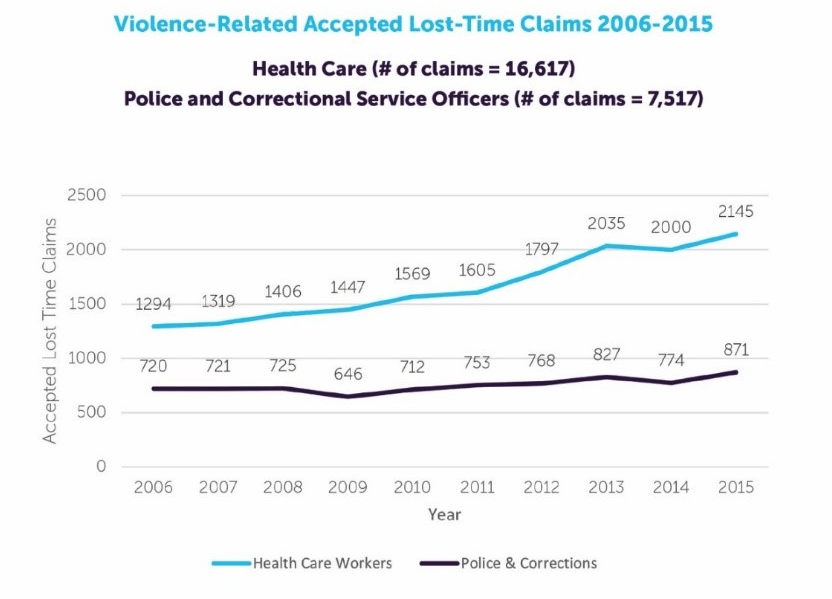
These sources provide a quantitative snapshot of violence and safety in the health care workforce in Canada.

Association of Workers’ Compensation Boards of Canada
A library of statistical data on lost time claims and fatality statistics in Canada by gender, age, industry, occupation, and injury type.
CFNU, 2017
This report is an urgent call for an effective health human resources plan that supports safe nurse staffing levels. Focuses on the nearly $2 billion in the total cost of nurses’ overtime and nursing absenteeism.
CFNU, 2017. The Vector Poll
According to a national poll of CFNU members, the majority of nurses responding (61%) say they have experienced serious problems in the workplace, related to violence, including physical assault, bullying, verbal abuse and racial/sexual harassment. In contrast, another national Vector poll found that just 15% of other sectors’ employees experienced serious problems with physical assaults, verbal threats, bullying or other kinds of abuse over a two-year period.
Centre for Research & Education on Violence against Women and Children; Canadian Labour Congress.
Wathen, C. et al.
Details the results of a survey of over 8,000 Canadian workers on their experience of domestic violence and the workplace. About a third of those surveyed had experienced, or were experiencing, domestic violence and of these over half reporting domestic violence abuse was experienced at, or near, the workplace.
Employment and Social Development Canada, 2017
Most survey respondents reported having experienced harassment, sexual harassment or violence more than once. Harassment was the most common type of behaviour experienced by a full 60 percent. Thirty percent of respondents said that they had experienced sexual harassment, 21 percent that they had experienced violence and 3 percent indicated they had experienced sexual violence.
First Reference infographic
Occupational Health Clinics for Ontario Workers Inc. and the Mental Injury Tool group. Survey Results
National Research Centre for the Working Environment’s short questionnaire for assessment of the psychosocial work environment. Comparison data based on a survey of 4,113 Canadian workers.
The latest results of the annual survey of the public service show a disturbing rise in workplace harassment and a significant rate of workplace stress.
Statistics Canada. Workplace harassment is more common in health-related occupations.
“Overall, workers in health occupations (which includes nurses and doctors) had a 23% probability of reporting that they had been harassed in the workplace, even after controlling for other factors. This likelihood was greater for women (27%) than for men (21%).
By contrast, workers in natural and applied sciences (which includes occupations such as engineers and computer and information system professionals) had a 9% probability of reporting having experienced workplace harassment.”
Statistics Canada, Canadian Institute for Health Information, and Health Canada
Nurses all across the country answered many questions and offered their perceptions of the environment in which they practice and the challenges they face in doing their jobs. They shared their experiences and views of work organization, including staffing, shift work, overtime and employer-supported perks.
Workplace Bullying Institute, 2012. Blog
552 full-time employed Canadians (non-government, not self-employed) were surveyed. These are the results and comparisons to the statistics from WBI studies.